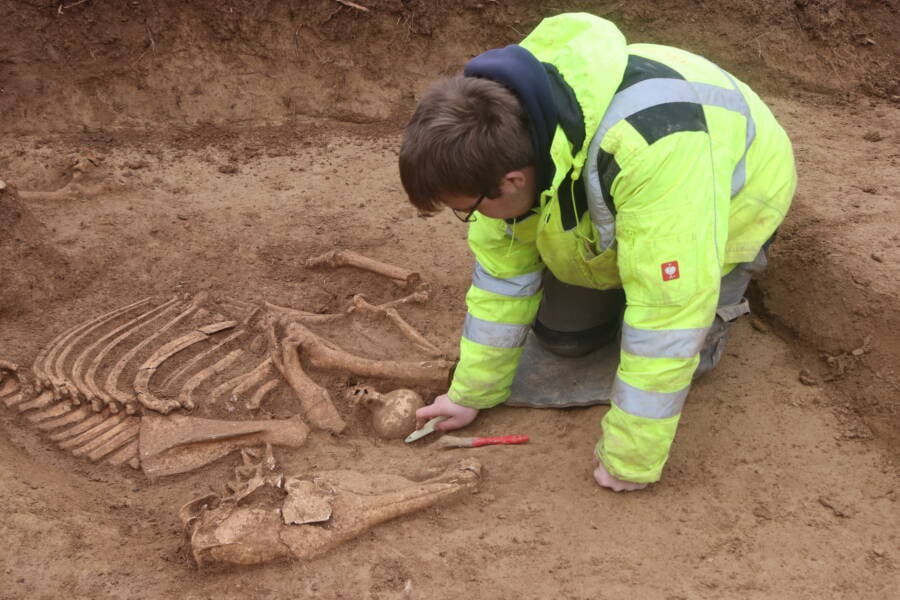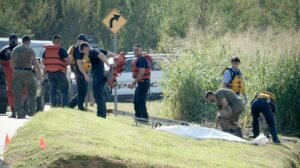“Unearthed: 1,900-Year-Old Roman Horse Cemetery Reveals Ancient Military Secrets”
Oh, the millennia-old drama! Picture this: a dusty old dig site, archaeologists scratching their heads, and then—ta-da—they unearth what looks like the world’s fanciest equine graveyard in the heart of Stuttgart, Germany. Because apparently, even Roman cavalry horses got better burial rights than some of us get parking spots!
You’ve got to wonder, what’s next in the housing development lottery? A chariot dealership from the Iron Age? A Neolithic farmers’ market? While surprises in this line of work must be like finding an ex at your family reunion—unnerving, yet somehow expected—the housing developers are digging up more than dirt here. They hit historical pay dirt!
As for the Roman horse cemetery discovered in this modern-day housing development, it makes you ponder—what did these ancient equines see in their lifetimes? What tales would they whisper if their bones could talk?
So, folks, let’s saddle up and dive into the details. Saddle up with that live hyperlink to gallop over to LEARN MORE.
While preparing for construction of a housing development in Stuttgart, archaeologists uncovered an ancient horse cemetery that was used by the Roman cavalry unit stationed nearby in the second century C.E.

State Office for Monument Preservation in the Stuttgart Regional Council/ArchaeoBWOne of the horses buried at Stuttgart’s Roman horse cemetery, which was located near an ancient cavalry fort.
In the 1920s, the extremely old remains of a horse were discovered in Bad Cannstatt, a historic district in Stuttgart, Germany. Locals long suspected that the site was an ancient Schindanger, or an animal disposal yard. Now, a recent housing development project in the area has revealed that this site was much more expansive than previously suspected. In fact, it was the site of a sprawling Roman horse cemetery in the second century C.E.
Positioned near an ancient Roman cavalry fort, the cemetery was largely a disposal ground for horses who’d died from illness or injury, or who could no longer be used as war horses. Though most were buried with little ceremony, at least one of the horses was buried with significant care, providing an interesting look at the relationship between man and animal in ancient Rome.
The Ancient Roman Horse Cemetery Unearthed In Stuttgart, Germany
According to a press release from the Stuttgart State Office for Monument Preservation (LAD), excavations at the site began in July 2024 ahead of construction on a new housing project. The excavations confirmed what people had suspected for a century: the site had been used as an animal disposal yard long ago.

State Office for Monument Preservation in the Stuttgart Regional Council/ArchaeoBWHorse remains were found at the area in 1920, and excavations a century later confirmed that the site had been used for animal disposal by the ancient Romans.
Specifically, this site had been used to dispose of Roman cavalry horses. The disposal yard is located close to a cavalry fort where a unit known as “Ala” was stationed between 100 and 150 C.E., roughly 300 years before the fall of Rome.
“The troop, with almost 500 riders, is likely to have had a total horse population of at least 700 animals, and losses had to be constantly replaced,” LAD lead archaeologist Sarah Roth explained in the press release. “The horses do not all appear to have died at the same time in a major event such as a battle or epidemic. Rather, the animals buried here either died of illness, injury… or were no longer able to fulfill their role as military horses.”
Most of the burials were unceremonious. Horses that died naturally were summarily disposed of. Horses that could still walk were lead to the cemetery, where they were killed on site and hastily buried.

State Office for Monument Preservation in the Stuttgart Regional Council/ArchaeoBWAn archaeologist with one of the approximately 100 Roman horse skeletons found at the site.
That said, at least one horse was buried with a bit more care.
The Close Bond Between Roman Soldiers And Their Horses

Carole Raddato/Wikimedia CommonsA Roman charioteer and his horse, as depicted in a mosaic from the third century C.E.
As the press release notes, there was one outlier among the horses who’d been “disposed of” at the Stuttgart cemetery. One of the horses appeared to have been buried with considerable love and attention, suggesting that the animal had shared a special bond with its rider.
This horse was buried with grave goods more typically found in human graves, including two jugs and small oil lamp, which had been tucked into the crook of one of the horse’s legs.
“Here we see a particularly close bond between the owner and his horse,” Roth noted in the press release. “Even after some 1,800 years, the grief over the death of this one animal is still evident.”
Indeed, horses held an important place in Roman society for many centuries before the empire fell. An extreme example of this fact is the story, likely apocryphal, that the Roman emperor Caligula attempted to make his horse into a senator. But soldiers and others did generally treat their horses with care, though the life of a military horse in ancient Rome could be short and brutal.
Auto Amazon Links: No products found.














